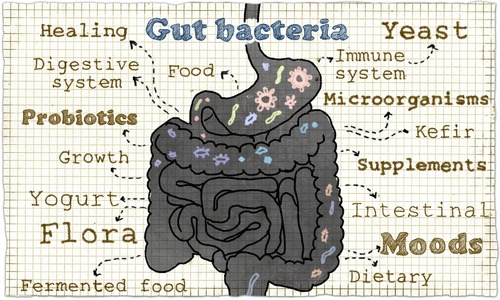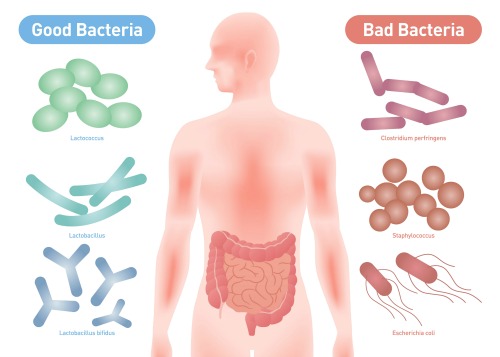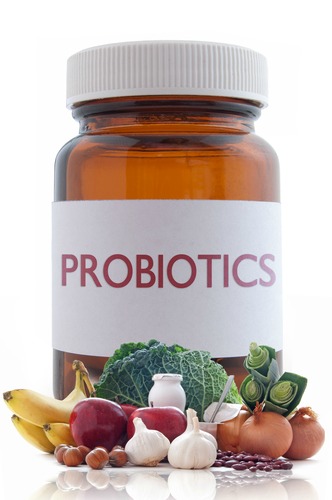The Microbiome in the human organism is a vast ecosystem of microorganisms that live and thrive throughout the long tunnel that runs from our mouths to our anus like microbial wallpaper. Externally there are vast colonies that live on our bodies, in our mouth,on our skin, under our arms.
So not only are we a complex chemical factory but we also a walking garden of Bacteria. Richard Dawkins stated in his book ‘Unweaving the rainbow’ :
 ‘Each of us is a city of cells,
‘Each of us is a city of cells,![]()
Each cell a Town of Bacteria,
You are a giant megalopolis of bacteria’

We can’t survive without our Microbiome!
The human organism cannot survive without the symbiosis between our host physiology and the microbes that live within our body. We need them ( bacteria ), and they need us (Host ). Our microbial ecosystem exists to help us digest our food, regulate our immune system, protect us from harmful pathogens and manufacture essential vitamins.
Some references identify 1000 different species with 7000 different strains..good luck in sequencing that community of microbes. Bacterial strains are analogous to dogs, where all dogs are the same species but there are many breeds ( or strains ). Some estimate that the volume of viruses outnumber bacteria followed by Fungi.
If this is indeed true then the human population is playing ‘Russian roulette’ if they follow a diet which is not commensurate with our beneficial gut flora, but providing a fine dining environment for our opportunistic and Pathogenic flora.
This situation is exacerbated by people’s obsession for cleanliness (antiviral this soap, antimicrobial that shampoo etc) and in most instances people’s belief that taking antibiotics is necessary even for ear infections ( the 18 doses of antibiotics given to infants within the first years of life is madness. How did Jama 12 2008 vol 300 put it?
“Allopathic medicine is a Categorical misclassification with etiologic imprecision.”
Furthermore if a fungus is activated it can cause, for example Aspergillosis ( a fungal infection from a common mold ) and if the recipient has a compromised immune system; most of which is resident in our gut flora then you may be at the mercy of any one of 8 or more prescription drugs such as ‘Posaconazole’, an antifungal drug which comes complete with 40 or so side effects.


A Closer Look at our Microbiome
For now I want to zoom in on our microbe population and digestion.
It is believed by some scientists that having a microbiome is non essential for digesting food since experiments have revealed that ‘sterile’ ( no microbiome ) guts in mice are still able to digest food but must be given all essential nutrients since Vitamin (B complex incl B12 and K2) synthesis ( another role that our microbiome performs ) is absent.
Well, given the low diversity of a mice diet ( grains, cheese, chocolate, cardboard etc) they can probably get away with it, but humans, forget about it.
Humans consume in general, a variety of complex carbohydrates our digestive system alone cannot break down, but rely on the gut to do the job. Starch from wheat, oats, rye, barley, buckwheat, rice.potatoes and legumes and fibre from whole-grain bread, brown rice, legumes, vegetables and fruits are common Glycans (Polysaccharides and oligosaccharides or simple sugars) that provide nourishment (development, growth, functioning, and even survival) to our microbial friends. We are all not just dining for one but for trillions.
The metabolism of many of these are beyond the ability of the host to digest so both host and microbes have to complete the task. Foods like bananas, onions, chicory root, garlic, asparagus and leeks contain fructooligosaccharide, a prebiotic substance that our enzyme arsenal ( Glycoside hydrolase ) cannot digest which is the same problem with Cellulose but our microbiome can.
Many nutritional experts warn against the over consumption of Oxalate rich foods. What are Oxalates ? ( we will reserve a more in depth discussion in future articles because of the abundance of research on this subject).
For now, Oxalates are salts that contain 2 carbons and 4 oxygen molecules and have -2 charge that makes them attractive to calcium which is +ve charged and less so to Magnesium.
In nature, many plants ( vegetables and Fruit ) contain oxalates to protect themselves from infection or being eaten ( the oxalate content tears up the teeth of the bug and they stop ), Foods such as Spinach, dates, grapefruit, orange, avocadoes, carrots, celery, nuts are high on the oxalate index. Even chocolate or at least milk chocolate which has certain amount of calcium in it, so for ‘chocoholics’ of which I am one, beware.
The good news is that if you have a healthy microbiome bacteria that reside in the colon ( large intestine ) including Oxalobactor formigenes, Eubacterium lentum ( strain ), and Enterococcus faecalis, they all metabolise oxalates ( there are in fact 18 identified microbial beneficial species known to degrade oxalates including Lactobacillus, and Bifidobacterium ).
Environmental pH levels are important since for example Oxalobactor formigenes provides optimal oxalate degradation at a pH level of 6.4 (slightly acidic ) so if body pH imbalance exists this could have an affect on oxalate metabolism.
If you do not have a healthy gut, and calcium absorption is low, due, maybe to low stomach acid, then dietary oxalates can combine with calcium which could lead to the development of kidney stones.
This is yet another great example of host-microbiota symbiosis because mammalian physiology does not have the enzymes to degrade oxalates; the human host relies on the resident gut bacteria to metabolise it, so this symbiosis maintains a healthy oxalate balance in the body.
Some scientists state that Metabolic syndrome, Autism, fibromyalgia, etc are associated with Lithiasis (…dont you just love medicines secret language and labels ?, and this one just means stoney concretions ( calculi) that develop in the body such as kidney stones ). Could all of these conditions be caused by gut dysbiosis ?..Hippocrates seemed to think so.
Feeding Your Microbiome
 A well nourished gut flora contains around 150 microbial species that has over 9,000 glycoside hydrolase enzymes and 2,000 polysaccharide lyases, thus providing an estimated 60,000 carbohydrate degrading enzymes.
A well nourished gut flora contains around 150 microbial species that has over 9,000 glycoside hydrolase enzymes and 2,000 polysaccharide lyases, thus providing an estimated 60,000 carbohydrate degrading enzymes.
Within the microbial communities, it is known that there is cross feeding that occurs between species and its this nutritional interaction that ultimately shape the microbes metabolic capacity, where one species will digest a substance and secrete a metabolite ( chemical fingerprints of cellular processes ) such as lactic acid, acetic acid or butyrate which are then ingested by other microbial species to achieve optimal energy for the host.
Propionate is a microbial fermentation metabolite that is promoted by dietary intakes of Arabinoxylan ( a substance found from the outer shell of wheat and rice ) and available as a dietary fiber supplement, or Polydextrose which is a synthetic sugar fiber and only partially fermented by our gut microbes ( Since Polydextrose is used in processed food like ‘Cocoa Pebbles’ as bulking agents to make reduced calorie products taste better I would recommend avoiding it even though Fred Flintstone appears on the box ).
I believe that science and nutritional research all agree that consuming a high fibre diet consisting of fruit,vegetables and legumes increase the production of health promoting Short chain Fatty acids ( SCFA ).
As mentioned above propionate, acetate and butyrate are all examples of SCFA produced by bacterial fermentation of insoluble fiber from plant sources. It has been discovered that the majority of individuals with a healthy gut maintain 3 dominant bacterial phyla : Bacteroidetes, Firmucutes and Actinobacteria. However in 2006 researchers at the Washington University school of medicine discovered that obese people had less of Bacteroidetes ( Bacteroides ) than Firmicutes so scientists have the notion that transplanting a gut flora with the ratio reversed i.e more Bacteroides less Firmicutes could be an answer to reversing obesity and it appears to work in mice.
The fact that obesity is a nutrient deficiency causing the individual to binge eat to compensate for the lack of essential nutrients ( similar to a horse that is suffering with Pica so the owner knows it’s cheaper to feed the horse with the nutrients missing than to rebuild the barn that he is anxiously chewing) does not enter into the equation.
What about insulin signals that are constantly active shutting out Leptin signals from the adipose tissue to trigger satiety to the Hypothalamus? This was proven by the wonderful work of Dr lustig. I guess that’s irrelevant as well.
Scientists actually believe that transplanting the microbiome or changing the ratio using specific food ( like beans ) is enough without making any other lifestyle changes like fixing nutrient deficiency, stress control and a healthy diet.
Two dietary recommendations would be to follow a high fiber diet rich in fruits and vegetables, as I stated before and avoid high amounts of sugar and processed food which will maintain control of Firmicutes allowing Bacteroides to dominate.
The Housekeeper of your Digestive System
“The microbiota is the housekeeper for the digestive system,”
Dr Natasha Campbell Mcbride the brilliant neuroscientist and naturopath doctor who devised the GAPs ( Gut and psychology/Physiology ) diet used by hundreds of families within her practice in Cambridge UK.
The purpose of our digestive system is to digest/absorb food and nutrients but it can only do so if the microbiota is functioning efficiently and the various microbial colonies are happy and fed well with nutritional food.
Two foods that people discuss in terms of intolerance is milk (Casein protein) and wheat (Gluten protein). I hear doctors talk about lactose ( milk sugar ) intolerance which is caused by a missing enzyme ( lactase ) unless you are of European extraction.
Food companies have made a whole range of gluten free products because some individuals eating bread causes an allergic reaction, as if by magic a percentage of the world’s population suddenly cannot eat wheat.
Milk and wheat have been part of the human diet for 10,000 years and now in the last 20 years people have become intolerant?
This does not make any sense, unless you consider that vast numbers are not eating real food anymore, thus compromising their own digestive housekeepers.
When milk (Casein protein) and wheat (Gluten protein) are ingested the stomach splits these proteins into peptides (a kind of short chain amino acid) which then travel to the small intestine where they are further digested by pancreatic enzymes (peptidase ) that reside on the brush border (microvilli) of the enterocytes (cells of the intestinal wall or epithelial).
It is this stage that fails, causing intolerance because of the poor state of the enterocytes. The natural replacement cycle of enterocytes occurs when epithelial daughter cells are constantly produced from the stem cells that are located in the crypts at the bottom of each intestinal gland.
Each ‘newborn’ epithelial cell slowly travel to the top of the Villi ( where nutrients are absorbed ) performing their digestion and absorption tasks, and when they reach the top they are shed off and in this way the enterocytes are constantly replenished.
It might be appropriate to include the following table which displays a biological ranking ( Taxonomy ) for living organisms (a taxon) which specify Species, Genus, Family, Order, class, Phylum, Kingdom, Domain.
| RANK | Bacteria ( E.Coli ) | Human |
| Species | E.Coli | Homo Sapien |
| Genus | Escherichia | Homo |
| Family | Enterobacteriaceae | Hominidae |
| Order | Enterobacteriales | Primate |
| Class | Gammaproteobacteria | Mammalia |
| Phylum | Proteobacteria | Chordata |
| Kingdom | Bacteria | Animalia |
| Domain | Bacteria | Eukarya |
E.Coli or Escherichia Coli is a bacterial colony that lives in the intestines alongside other colonies including Lactobacillus Reuteri ( an antimicrobial beneficial strain that inhibits growth of pathogenic species ), Lactobacillus Casei ( beneficial strain for digestive health ), Lactobacillus gasseri ( beneficial strain for weight management ), Bifidobacteria ( Beneficial genus used for carbohydrate metabolism), Bacteroides thetaiotaomicron b ( Beneficial strain used to harvest and metabolise dietary polysaccharides -starch, glycogen, cellulose carbohydrate ).
Many strains of E.Coli are harmless but certain strains like the infamous O157:H7 are pathogenic which can cause food poisoning.
Within ideal conditions, bacterially speaking, a single E.Coli cell can become over a billion cells in 10 hours. I mentioned above the existence of lactose intolerance since E.Coli is one of the major lactose digesting bacteria and its absence will contribute to this condition.
It is this species that appear in huge numbers (10*7-10*9 CFU ( Colony Forming Unit )/g in the gut of a baby from the first days of birth. Furthermore certain strains produce Vitamins K2,B1,B2,B6,B12 for the human host within the colon and antibiotic substances called Colicins.
Other beneficial bacteria also synthesize nutrients such as Vitamins K2, B5,B1,B2,B3 B6,B12 and folic acid. Nature in its infinite wisdom ensured that the body is nourished when food is hard to come by, however if the microbiome is damaged then nutrient synthesis is compromised, since these nutrients do not stay in the body long enough and need to be replenished within hours.
What is a Probiotic?
The bacterial species discussed so far are beneficial flora and are probiotic species( opportunistic flora will be discussed in subsequent articles ).
Probiotic products are sold on the basis of replenishing the existing flora. Common bacterial species like Lactobacillus Acidophilus which maintain a certain acidity in the body by producing lactic acid ( hence the word ‘Acid’ in acidophilus ) and Hydrogen peroxide which discourages the proliferation of harmful bacteria.
This species also produces vitamin K and Lactase enzymes to break down milk products ( hence the ‘Lacto’ in Lactobacillus).
This bacteria is 0.6 * 1.5 micrometres which is 10,000 times smaller than a Pinto bean..imagine.
Other probiotic species are Lactobacillus rhamnosus thrives in acidic conditions and it to produces lactic acid and provides benefit to our neurological pathways and treatment of any not so friendly bacteria like Candida. Bifidobacteria longum is also a common species that are added to probiotic products, which is an anti-inflammatory that protect cells that line the mucous membranes.
It also provides other benefits including the production of enzymes that digest proteins, provides bone health properties, prevents colon cancer ( as does Butyrate from Butter ) and lowers cholesterol.
One thing to keep in mind is that 99% of all bacteria that make up our microbiome function anaerobically, that is without oxygen which is why it is impossible to culture these bacteria in vitro. Furthermore all probiotic products exist in oxygen so the question is how do probiotics work?
Most holistic doctors believe that bacterial strains in foods like yogurt simply feed our microbiota and clean the colon but it does not re-colonize our bacteria. So do kefir, kombucha, and fermented foods help re-colonize or simply feed our bacteria?
It was Ilya Metchnikoff a russian scientist born in 1845 who thought that the human colon was a Vestigial cesspool and hypothesised that the microbes in yogurt might be beneficial to our gut.
The Shikimate Pathway
Before I conclude there is one more duty that our wonderful microbes perform which is the manufacture of some very important ‘aromatic’ amino acids Phenylalanine,Tyrosine and Tryptophan using a 7 step metabolic route called the Shikimate pathway.
Only our own microbiota can achieve this, since they are the only community that have this pathway. All 3 amino acids are essential to human health. Phenylalanine and Tyrosine are needed to produce neurotransmitters Epinephrine, Norepinephrine and Dopamine that control the way we perceive and interact with our environment, while Tryptophan produces Niacin and Serotonin for healthy sleep and stable mood patterns. However, the consumption of genetically modified organisms in our diet heavily laden with the herbicide Glyphosate disrupts this pathway and over time can erode your health. More on this topic later.
Remember Hippocrates said…
“Bad digestion is the root of all evil.”
“Fools! They refuse to believe life exists in meteorites. I showed them at the astrophysics conference what I just showed you.But no! Even with a microscope they are blind! But what do I have to do? Hit them over the head? “
The Andromeda Strain
Author: Eric Malouin
Reviewed by Dr. John Bergman D.C.


